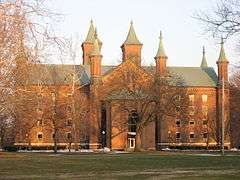WYSO
|
| |
| City | Yellow Springs, Ohio |
|---|---|
| Broadcast area | Dayton, Ohio |
| Slogan | Our Community. Our Nation. Our World |
| Frequency | 91.3 MHz (also on HD Radio) |
| First air date | 1958 |
| Format | NPR/Public Radio |
| Audience share | 1.9 (FALL 2007, RRC[1]) |
| ERP | 55,000 watts |
| HAAT | 122 meters (400 ft) |
| Class | B |
| Facility ID | 2374 |
| Transmitter coordinates | 39°45′46.00″N 83°52′59.00″W / 39.7627778°N 83.8830556°W |
| Callsign meaning | Yellow Springs, Ohio |
| Former callsigns | none |
| Affiliations |
National Public Radio, Public Radio International, BBC World Service |
| Owner |
Antioch College (Antioch College Corporation) |
| Webcast | Listen |
| Website | 91.3 WYSO |
WYSO (91.3 FM) is a radio station in Yellow Springs, Ohio, near Dayton, operated by Antioch College. It is the flagship National Public Radio member station for the Miami Valley, including the cities of Dayton and Springfield.
WYSO signed on in 1958 and has the distinction of being located in one of the smallest villages to host an NPR affiliate station. WYSO broadcasts in the HD Radio format.[2]
History
WYSO started as a student and faculty station with a 10-watt transmitter located at the student union building of Antioch College, an institution with a unique progressive philosophy. By the early 1970s, an intermediate power increase to 3000 watts and the introduction of permanent paid staff began a move towards reflecting and serving a larger community. At that time, WYSO was known as a university-based community radio station. Significantly, several Antioch College students and other volunteers took it upon themselves to be involved with an incipient community and public radio movement in the United States. Several of those individuals have occupied key positions since that time—out of proportion to the station's modest size.[3][4]
Before NPR affiliation, nearly all of the station's programming was locally originated. The station had carried live Metropolitan Opera radio broadcasts, ad hoc networks set up by anti-Vietnam War activists, and a few recorded syndicated programs. "WYSO People's News" a local news program, was aired in the 1970s and 1980s. The rest of WYSO's program schedule was eclectic and block programming.
As at other community radio stations in the United States, NPR affiliation was viewed with suspicion by some insiders, but the attendant money from the Corporation for Public Broadcasting led to a permanent staff and a local fundraising mandate.
WYSO became an NPR member station and started broadcasting All Things Considered at the time of the first power increase sometime between 1971 and 1973. The eventual popularity of NPR's news and information programming was not foreseen at the time and there were endless discussions about how the newly energized medium of noncommercial radio would best serve the community. The topic of local versus national origination was an important, but not the only, subject of debate. The decision to replace morning Bluegrass music, local and unique to the region, with network news in the morning was undertaken in the late 1980s. Tom and Jim Duffee and other local bluegrass musicians introduced the genre on WYSO around 1970, and it was embraced by management at the time as a link with the larger Southwest Ohio community.
In the spring of 2002, a group of listeners formed "Keep WYSO Local" in response to cutbacks to local programming.[5] The group continued to debate the future of the station with the University.[6]
Programming
Locally produced Rise When The Rooster Crows, once a daily morning feature, now airs traditional Bluegrass music on Sunday mornings. Morning Edition has aired in its place since the late 1980s. Bluegrass music is also aired on Saturday evenings with the program "Down Home Bluegrass."
Programming from Public Radio International and BBC World Service is also aired.
Management
Most local programming, as measured by airtime, is produced by volunteers. Volunteers, listeners and donors to the station have asserted an unofficial role in station governance since the 1970s when the station was managed under Antioch's Community Government. The University holds the license and administrators now hire the professional staff.
In December 2008, WYSO announced that Neenah Ellis, a public radio producer and host would be the station's next general manager. She and her husband, NPR host and author Noah Adams, would make their home in Yellow Springs.[7]
References
- ↑ "Dayton Market Ratings". Radio Research Consortium. Arbitron. Fall 2007.
- ↑ http://hdradio.com/station_guides/widget.php?id=58
- ↑ Walker, Jesse (2001). Rebels on the Air: An Alternative History of Radio in America. New York University Press. ISBN 0-8147-9381-9.
- ↑ NPR's John McChesney remembers starting out at WYSO
- ↑ Chiddister, Diane (2002-12-05). "KWL responds to claims made by WYSO Resource Board members". Yellow Springs News. Retrieved 2009-03-05.
- ↑ "Back in action: Keep WYSO Local". Dayton Daily News. 2008-04-08. Retrieved 2009-03-05.
- ↑ Laura Dempsey (2008-12-08). "WYSO picks NPR veteran as new GM". Dayton Daily News. Retrieved 2009-01-14.
External links
- 91.3 WYSO
- Query the FCC's FM station database for WYSO
- Radio-Locator information on WYSO
- Query Nielsen Audio's FM station database for WYSO
